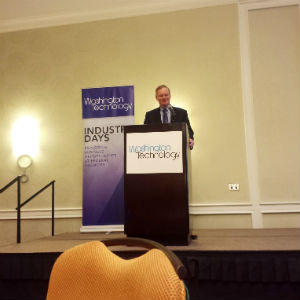Cloud, mobility investments on the rise
Executives from a range of civilian and defense agencies spoke about growing cloud and mobility opportunities as those technologies embed themselves into agency infrastructures.
In the fifth of our series of Washington Technology Industry Days, a number of agency executives took a dive into the mobility and cloud priorities, opportunities and procurement culture at their agencies.
We hosted representatives from agencies such as GSA, EPA, DISA and DHS, and each government executive emphasized a desire to partner effectively with contractors and highlighted opportunities for contractors to keep their eyes on in the near future.
Our next industry day will focus on the Homeland Security Department and is taking place on Dec. 1.
Mobility in Government: The Road Ahead
Robert Palmer, deputy director (acting), Enterprise System Development Office, Department of Homeland Security
Palmer said that the Homeland Security is focused on supporting mobile devices.
“How are we going to secure them, distribute them, maintain them, how do we integrate commercial capabilities with what we want from a federal perspective,” he said.
Palmer also noted the challenges of users wanting to use commercial devices like iPhones and Android phones, but making those smart devices secure.
As for working with the agency, DHS is focused on secure identities. “If there is one [opportunity] I could think of right now, it’s how to get this thing on a mobile device,” Palmer said, holding up an identity card.
The agency is also focused on procurement and making the process faster. “I know that a lot of this is not on industry’s side, but it does help to have everybody coming at it,” he added.
He also mentioned data protection.
“The way that we approach [data protection] right now is throw it all in a massive vault and throw a bunch of protections around it, but that doesn’t make it very easily accessible, which is contrary to what we’re trying to do from this mobile perspective, which is open architecture," he said.
Moving Beyond the Low-Hanging Fruit
Stan Kaczmarczyk, director, Cloud Computing Services Program Management Office, Office of Integrated Technology Services, Federal Acquisition Service, U.S. General Services Administration

Kaczmarczyk started out by explaining the general perspective on cloud: it’s more secure to be in the cloud than to do it yourself.
He then outlined how contracting dollars have been spent through GSA blanket purchase agreements. The Information-as-a-Service BPA, for example, has more than 20 government agency customers and $52.1 million in sales.
Kaczmarczyk also talked about projections for cloud spending. In fiscal 2016, agencies are projected to buy $2.250 billion in cloud services through GSA, with total customer cost savings of $306.8 million, and in fiscal 2017, GSA is projecting $2.254 billion, with customers saving $331.9 million in costs.
Part of this spending will be done through a new contract vehicle as well as through IT Schedule 70.
The agency is looking to improve not just Schedule 70, but on all of its major BPAs over the past six years.
“We found out that on [previous contracts], agencies needed professional services. They needed something to help them migrate to the cloud environment and integrate into the cloud environment.” Kaczmarczyk said.
Those professional services will include assessment, planning, migration, integration and maintenance.
The new contract will also be flexible enough to keep up with the fast pace growth of cloud products and services. It will also leverage industry investment in FedRAMP certification.
One thing to note, however, is that the new contract will not be a BPA. Instead, Kaczmarczyk said, it will either be an IDIQ or a GWAC contract.
“We hope to have a draft request for proposals that’s out on the street in FY16,” he added, but admitted that the agency wants to take the time to get it right to avoid further trouble.
“You can’t cut corners on these procurements. If you try to rush them in the beginning, you don’t get the requirements right. If you try to rush them during the evaluation phase, then you have a poor evaluation, and you have all sorts of protests.”
DISA: Building Out the Mobility Portfolio
Kimberly Rice, mobility portfolio manager, DoD Portfolio Management Office
Rice talked about some of the issues that program offices have when rolling out their initial billing offer for the department. She also went into some of the agency’s main goals, one of which is commercial technologies.
“In the future, we’re going to improve that offering and really align with where we see commercial.”
Along those lines, the agency is also very focused on “bring your own device” policies and making smartphones and tablets secure enough for people use.
“The mobility service from DISA’s perspective is doing very well. We’ve seen a significant increase in the number of users since we started deploying some of the major capabilities this year.”
Looking ahead, one unclassified objective that DISA is focused on is direct credential partnership.
Mobility: Leveraging the Power of the Cloud
Harrell Watkins, COO and director, Office of Technology Operations and Planning, Environmental Protection Agency
The EPA began its push toward the cloud in 2012, Watkins said. That year, the agency transitioned to Microsoft Office 365, with approximately 25,000 employees making the switch. The initial transition took five months, Watkins said.
In 2014, the EPA moved from Blackberry devices to Apple and Android smartphones. This year, the EPA has begun offering iPad and Windows 8 tablets.
Watkins then went into some of the goals of the agency, which he broke up into cloud computing goals and mobility goals.
“We want to make sure we align our agency direction and goals to the federal CIO ‘cloud first’ strategy,” Watkins said. The EPA is also interested in expanding their private and public cloud footprint to improve overall performance, scalability and reduce operational and license cost.
As for mobility, the EPA wants to improve employee productivity by enabling a more mobile workforce.
“One of the big things, particularly for EPA, where we can reduce our footprint. We want to enhance mobility and access information from anything, anywhere. One of the big [challenges] is ensuring that we are able to do that while also staying compliant with federal security requirements,” Watkins said.
As for their mobility strategy, the EPA wants to expand its use of Microsoft Office 365 features and to develop an Enterprise VDI, Watkins said.
It is also looking to develop a cloud brokerage to help manage its cloud initiatives.
Finding the Cloud and Mobility Opportunities
Deniece Peterson, director, Federal Industry Analysis, Deltek

Cloud opportunities are everywhere, Peterson said, but they are often linked to other opportunities.
“Everything is tying together. If you’re focused on data centers, there are cloud opportunities embedded there. And where there are cloud opportunities, there are security opportunities,” Peterson said.
In terms of numbers, there is projected to be a $25 billion increase in discretionary spending in 2016 thanks to the Bipartisan Budget Act of 2015, which allows a two year reprieve from sequestration.
“Now [agencies] have two years of budget where they have a general idea of what it’s going to be,” Peterson said.
Cloud computing and mobility are two of the top three growing mission areas for agencies and will drive agencies’ IT investments over the next few years, Deltek found.
Peterson also highlighted some trends influencing federal cloud computing, including FedRAMP picking up the pace, risks associated with non-FedRAMP compliant cloud solutions being used by agencies, and challenges that agencies face in managing cloud investments.
Peterson recommended that contractors look for cloud and mobility requirements written into general IT support, infrastructure modernization and data center contracts.
It was also recommended that contractors offer cloud-related services like brokering, strategy development and cloud engineering.
NEXT STORY: VSE founder dead at 87

